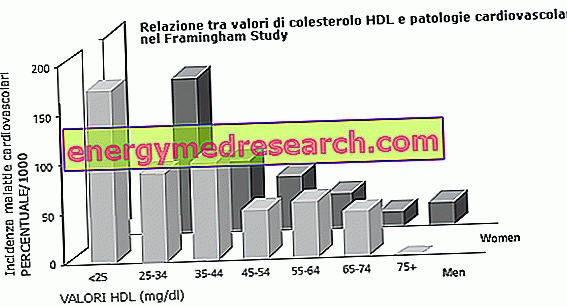Benefits of physical activity
If well structured, physical activity has been shown to reduce VLDL levels, hence plasma triglycerides, and increase HDL levels, hence good cholesterol.

| LDL cholesterol / HDL cholesterol | ||
| Cardiovascular risk * | Men | Women |
| Very low (halved) | 1 | 1:47 |
| Middle | 3:55 | 3:22 |
| Moderate risk (doubled) | 6:35 | 5.0 |
| Very High (tripled) | 8 | 6:14 |
Lifestyle
Given the above, the fight against high levels of LDL cholesterol cannot be separated from that against sedentariness.
- At least 30 minutes of physical activity per day
- Reduce saturated fats (animals) in favor of mono and polyunsaturated fats (vegetable oils)
- Increase fish consumption (omega-3 fatty acids)
- Increase fruit and vegetable consumption (5 portions per day)
- Avoid excess salt and sugar
- Not smoking
- Attention to excess weight
Equally important is to intervene with further changes in one's lifestyle; particular attention should be paid to abstaining from smoking, to weight loss, where necessary, and to any changes in the dietary intake. Only later will one have to think about drugs, indicated only when the change in lifestyle, after six weeks, is ineffective.
Recalling that the risk of cardiovascular accidents can be quantified on the basis of many other risk factors (see specific article), we recall how the practice of moderate physical activity - every day or almost - involves a 30-50% reduction in the risk of suffering coronary heart disease, compared to the sedentary population and other risk factors being equal.
The positive effects on cardiovascular health achievable through physical activity are maximum for those who pass from a sedentary lifestyle to the practice of regular moderate-intensity physical activity.

From the image above, we can see how low HDL cholesterol values are associated with a significant increase in cardiovascular risk.
People with plasma HDL cholesterol levels below 40 mg / dL are at greater risk of developing coronary artery disease, restenosis after angioplasty and dying from cardiovascular causes, especially if there are additional risk factors: male sex, being in menopause, smoking and suffering of diseases like diabetes and hypertension not perfectly controlled with drugs.
Importance of Losing Weight
Regular aerobic activity increases HDL cholesterol levels from 3 to 9% in adult, healthy and previously sedentary people. The increase in recordable HDL levels is greater the lower the initial HDL cholesterol levels, and the higher the triglyceride and abdominal fat values.
A meta-analysis of a large group of studies showed that in overweight people per kg of weight lost there is an increase in plasma HDL cholesterol levels of around 0.35 mg / dL. This effect is achieved only if the weight loss is stable, so if the weight reached is maintained over time.
It therefore appears that the greatest benefits of physical activity on HDL cholesterol levels are related to the weight loss it promotes.
What physical activity?
The degree of physical activity advisable to obtain good results, in terms of reducing LDL cholesterol and cardiovascular risk, can be quantified as follows:
at least 5 days a week of moderate intensity physical activity for 30-40 minutes a day, or at least 3 days a week of high intensity physical activity for 20-30 minutes a day. Other guidelines recommend at least 150 minutes a week of exercise with moderate to vigorous intensity.
Physical activity at moderate intensity does not lead to the exhaustion of forces and is equivalent, for example, to walking at a good pace (4/5 km / h), using the bicycle or the treadmill without too much effort, to practice non-competitive swimming or engaging in folk dances. Intense physical activities include, for example, aerobic gymnastics, jogging, tennis or swimming competitions.
To assess the intensity of the exercise one can also refer to the heart rate, as shown in this article.

Are there any contraindications?
In a healthy and healthy person there is no contraindication to the practice of regular physical activity, regardless of the degree of intensity at which it is performed. A preventive medical consultation is however always useful and becomes essential in the presence of certain conditions: cardiovascular diseases (angina, heart attack, stroke, intermittent claudication), reduced tolerance to physical exertion (shortness of breath, pain or sense of pressure in the chest that occurs during the 'exercise), severe osteoporosis, ongoing drug therapies, frequent episodes of dizziness or fainting, and pathological conditions in general.



